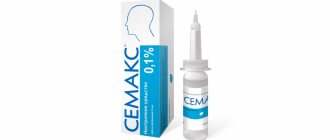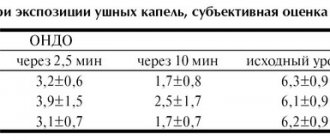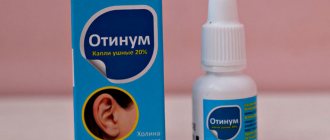Okomistin, 1 piece, 10 ml, 0.01%, eye, ear and nasal drops
The main active ingredient of the drug Okomistin® is the antiseptic benzyldimethyl-myristoylamino-propylammonium, which has a pronounced antimicrobial effect against gram-positive and gram-negative, aerobic and anaerobic bacteria in the form of monocultures and microbial associations, including hospital strains with multidrug resistance to antibiotics. The drug acts on chlamydia, pathogenic fungi, as well as herpes viruses and adenoviruses. The drug is more effective against gram-positive bacteria, including: staphylococci, streptococci. It has an antifungal effect on ascomycetes of the genus Aspergillus and the genus Penicillium, yeasts (Rhodotorula tubra, Torulopsis glabrata) and yeasts (Trichophyton rubrum, Trichophyton mentagrophytes, Trichophyton verrucosum, T. schoenleini, T. violaceum, Epidermophyton Kaufman-Wolf, E, floccosum, Microsporum gypseum , Microsporum canis), as well as other pathogenic fungi (for example, Pityrosporum orbiculare (Malassezia furfur)) in the form of monocultures and microbial associations, including fungal microflora with resistance to chemotherapeutic drugs. The action of benzyldimethyl-myristoylamino-propylammonium is based on the direct hydrophobic interaction of the molecule with the lipids of the membranes of microorganisms, leading to
to their fragmentation and destruction. In this case, part of the benzyldimethylmyristoylaminopropylammonium molecule, plunging into the hydrophobic portion of the membrane, destroys
the supramembrane layer loosens the membrane, increases its permeability to large molecular substances, changes the enzymatic activity of the microbial cell, inhibits enzyme systems, which leads to inhibition of the vital activity of microorganisms and their cytolysis. Benzyldimethyl-myristoylamino-propylammonium has a high selectivity of action against microorganisms, because has virtually no effect on the membranes of human cells, which is due to the different structure of the latter - the significantly longer length of lipid radicals, which sharply limits the possibility of hydrophobic interaction of benzyldimethyl-myristoylamino-propylammonium with cells.
Under the influence of the drug, the resistance of bacteria and fungi to antibiotics is reduced. Benzyldimethyl-myristoylamino-propylammonium has anti-inflammatory and immunoadjuvant effects, enhances local protective reactions, regenerative processes, activates nonspecific defense mechanisms due to modulation of the cellular and local humoral immune response.
Okomistin® (Okomistin®)
The main active ingredient of the drug Okomistin® is the antiseptic benzyldimethyl-myristoylamino-propylammonium, which has a pronounced antimicrobial effect against gram-positive and gram-negative, aerobic and anaerobic bacteria in the form of monocultures and microbial associations, including hospital strains with multidrug resistance to antibiotics. The drug acts on chlamydia, pathogenic fungi, as well as herpes viruses and adenoviruses. The drug is more effective against gram-positive bacteria, including: staphylococci, streptococci.
It has an antifungal effect on ascomycetes of the genus Aspergillus and the genus Penicillium, yeasts (Rhodotorula tubra, Torulopsis glabrata) and yeasts (Trichophyton rubrum, Trichophyton mentagrophytes, Trichophyton verrucosum, T. schoenleini, T. violaceum, Epidermophyton Kaufman-Wolf, E, floccosum, Microsporum gypseum , Microsporum canis), as well as other pathogenic fungi (for example, Pityrosporum orbiculare (Malassezia furfur)) in the form of monocultures and microbial associations, including fungal microflora with resistance to chemotherapeutic drugs.
The action of benzyldimethyl-myristoylamino-propylammonium is based on the direct hydrophobic interaction of the molecule with the lipids of the membranes of microorganisms, leading to their fragmentation and destruction. In this case, part of the benzyldimethylmyristoylaminopropylammonium molecule, plunging into the hydrophobic portion of the membrane, destroys the supra-membrane layer, loosens the membrane, increases its permeability for large molecular substances, changes the enzymatic activity of the microbial cell, inhibits enzyme systems, which leads to inhibition of the vital activity of microorganisms and their cytolysis. Benzyldimethyl-myristoylamino-propylammonium has a high selectivity of action against microorganisms, because has virtually no effect on the membranes of human cells, which is due to the different structure of the latter - the significantly longer length of lipid radicals, which sharply limits the possibility of hydrophobic interaction of benzyldimethyl-myristoylamino-propylammonium with cells.
Under the influence of the drug, the resistance of bacteria and fungi to antibiotics is reduced. Benzyldimethyl-myristoylamino-propylammonium has anti-inflammatory and immunoadjuvant effects, enhances local protective reactions, regenerative processes, activates nonspecific defense mechanisms due to modulation of the cellular and local humoral immune response.
Instructions for medical use of the drug Okomistin® (Okomistin®)
Registration number LSR-004896/09
INN or group name Benzyldimethyl-myristoylamino-propylammonium
Chemical name Benzyldimethyl[3-(myristoylamino)propyl]ammonium chloride monohydrate
Dosage form Eye, ear, nasal drops
Composition per 100 ml Active substance: Benzyldimethyl[3-(myristoylamino)propyl] ammonium chloride monohydrate (in terms of anhydrous substance) - 0.01 g
Excipients: sodium chloride - 0.90 g, purified water up to 100 ml
Description of the dosage form
Colorless transparent liquid
Pharmacotherapeutic group Antiseptic
ATX code S01AX
Pharmacological properties
Pharmacodynamics.
The main active ingredient of the drug Okomistin® is the antiseptic benzyldimethyl-myristoylamino-propylammonium, which has a pronounced antimicrobial effect against gram-positive and gram-negative, aerobic and anaerobic bacteria in the form of monocultures and microbial associations, including hospital strains with multidrug resistance to antibiotics. The drug acts on chlamydia, pathogenic fungi, as well as herpes viruses and adenoviruses. The drug is more effective against gram-positive bacteria, including: staphylococci, streptococci.
It has an antifungal effect on ascomycetes of the genus Aspergillus and the genus Penicillium, yeasts (Rhodotorula tubra, Torulopsis glabrata) and yeasts (Trichophyton rubrum, Trichophyton mentagrophytes, Trichophyton verrucosum, T. schoenleini, T. violaceum, Epidermophyton Kaufman-Wolf, E, floccosum, Microsporum gypseum , Microsporum canis), as well as other pathogenic fungi (for example, Pityrosporum orbiculare (Malassezia furfur)) in the form of monocultures and microbial associations, including fungal microflora with resistance to chemotherapeutic drugs.
The action of benzyldimethyl-myristoylamino-propylammonium is based on the direct hydrophobic interaction of the molecule with the lipids of the membranes of microorganisms, leading to their fragmentation and destruction. In this case, part of the benzyldimethyl-myristoylamino-propylammonium molecule, plunging into the hydrophobic portion of the membrane, destroys the supra-membrane layer, loosens the membrane, increases its permeability for large-molecular substances, changes the enzymatic activity of the microbial cell, inhibits enzyme systems, which leads to inhibition of the vital activity of microorganisms and their cytolysis. Benzyldimethyl-myristoylamino-propylammonium has a high selectivity of action against microorganisms, because has virtually no effect on the membranes of human cells, which is due to the different structure of the latter - the significantly longer length of lipid radicals, which sharply limits the possibility of hydrophobic interaction of benzyldimethyl-myristoylamino-propylammonium with cells. Under the influence of the drug, the resistance of bacteria and fungi to antibiotics is reduced. Benzyldimethylmyristoylaminopropylammonium has anti-inflammatory and immunoadjuvant effects, enhances local protective reactions, regenerative processes, activates nonspecific defense mechanisms due to modulation of the cellular and local humoral immune response.
Pharmacokinetics . The drug has a local effect. There are no data on possible penetration into the bloodstream.
Indications for use
Ophthalmology
Okomistin®, eye, ear, and nasal drops are recommended for use in the complex treatment of infectious processes in the anterior part of the eye (blepharitis, conjunctivitis, keratitis, keratouveitis), eye injuries, eye burns (thermal and chemical); in the preoperative and postoperative periods for the treatment and prevention of purulent-inflammatory eye lesions. Prevention of ophthalmia of newborns, including gonococcal and chlamydial.
Otorhinolaryngology
The drug is used in the complex treatment of acute sinusitis/rhinosinusitis, exacerbation of chronic sinusitis/rhinosinusitis, acute rhinitis; acute and chronic external otitis, chronic purulent mesotympanitis, otomycosis.
Contraindications
Individual sensitivity to the components of the drug.
Use during pregnancy and breastfeeding
The use of the drug during pregnancy and lactation is possible only if the expected benefit to the mother outweighs the potential risk to the fetus and child.
Directions for use and doses
Ophthalmology
Locally. For adults, for therapeutic purposes, the drug Okomistin® is instilled into the conjunctival sac, 1-2 drops 4-6 times a day until clinical recovery. For prophylactic purposes, the drug is instilled 2-3 days before surgery, as well as for 10-15 days after surgery, 1-2 drops 3 times a day. When treating eye burns, after washing the eye with plenty of water, perform frequent instillations (every 5-10 minutes) for 1-2 hours. For further treatment, the drug is used 1-2 drops 4-6 times a day. In pediatric practice, for the treatment of bacterial conjunctivitis in children, the drug Okomistin® is instilled into the conjunctival sac, 1 drop up to 6 times a day for 7-10 days. To prevent ophthalmia in newborns, immediately after birth, the child is instilled with 1 drop of the drug into each eye 2 times with an interval of 2-3 minutes.
Otorhinolaryngology
Locally. For adults with acute sinusitis/rhinosinusitis, exacerbation of chronic sinusitis/rhinosinusitis, acute rhinitis, infection of the nasal mucosa, Okomistin® is instilled 2-3 drops into each nostril, 4-6 times a day. The course of treatment is up to 14 days. In pediatric practice, for the treatment of acute rhinosinusitis, exacerbation of chronic rhinosinusitis in children over 1 year of age, the drug Okomistin® is instilled into each nasal passage, 1-2 drops up to 4-6 times a day for 10-14 days. For adults. Locally. For acute and chronic external otitis and otomycosis, the drug Okomistin® is instilled into the external auditory canal 5 drops 4 times a day or, instead of instillation, a gauze turunda soaked in the drug is injected into the external auditory canal 4 times a day. The course of treatment is 10 days. In adults with chronic mesotympanitis, it is used in complex treatment using hardware ultrasonic irrigation or injection into the tympanic cavity together with antibiotics. In the absence of positive dynamics (increased severity or appearance of new signs/symptoms of the disease, the occurrence of complications) on the 3-4th day of therapy using the drug Okomistin®, you must consult a doctor!
Side effect
Allergic reactions are possible. In some cases, a slight burning sensation and discomfort may occur, which go away on their own after 15-20 seconds and do not require discontinuation of the drug. If any adverse events occur, you should consult a doctor.
Interaction with other drugs
When used together, Okomistin® increases the effectiveness of topical antibiotics. Interaction studies of the drug with other drugs have not been conducted.
special instructions
Contact lenses should be removed immediately before instillation of Okomistin® and put on no earlier than 15 minutes after instillation. To avoid contamination and cross-infection, do not use the same vial to treat eye, nose, and/or ear infections at the same time. To prevent contamination of the drug solution during instillation, patients should avoid contact of the dropper tip with the eye and skin. Sharing the dropper bottle by more than one person may spread the infection.
Children
The drug can be used in pediatric practice.
Overdose
Not observed.
Impact on the ability to drive vehicles and machinery
After using the drug, a temporary decrease in the clarity of visual perception is possible and until it is restored, it is not recommended to drive a car or engage in activities that require increased attention and reaction.
Release form
Okomistin®, eye, ear, nasal drops, 1 ml or 1.5 ml in disposable polymer tube-droppers, 5 or 10 ml in polymer bottles, sealed with a dropper stopper and a screw-on cap with first opening control; 20 ml in glass bottles, sealed with a rubber stopper and an aluminum cap or a polyethylene dropper cap. 1 or 5 bottles or 5 or 10 dropper tubes with instructions for use in a cardboard pack.
Storage conditions Store at a temperature not exceeding 25°C. Keep out of the reach of children.
Shelf life - 3 years. Shelf life after opening is 1 month. Do not use after expiration date.
Conditions for dispensing from pharmacies
Dispensed with a doctor's prescription.
Registration Certificate Holder
LLC "INFAMED" 142700, Russia, Moscow region, Leninsky district, Vidnoye, ter. Industrial zone of OJSC VZ GIAP, building 473, floor 2, room. 9, tel.
Manufacturer
LLC "INFAMED K" 238420, Russia, Kaliningrad region, Bagrationovsky district, Bagrationovsk, st. Communalnaya, 12, tel.
Organization authorized to accept complaints
LLC "INFAMED" 142700, Russia, Moscow region, Leninsky district, Vidnoye, ter. Industrial zone of OJSC VZ GIAP, building 473, floor 2, room. 9, tel.


